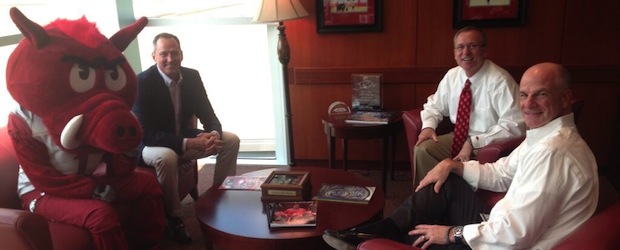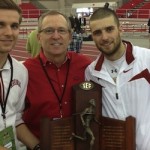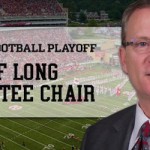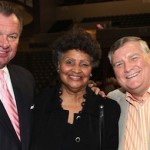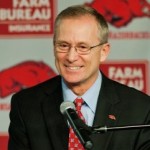University of Arkansas athletic director Jeff Long has been in the news a lot lately. It’s the type of top-of-the-sports-section coverage that used to be reserved for head coaches rather than administrators.
After a nibble from the University of Texas, it was announced last week that Long would receive a $100,000 salary increase to $1 million annually along with a $100,000 bonus. That’s not to mention another $100,000 raise on July 1, 2014.
A year ago, Long had received a $50,000 raise and an extension based on the way he handled the firing of Bobby Petrino as the Razorback head football coach.
Long had been in the news a few weeks earlier when he was selected as the first chairman of the selection committee for the college football playoffs that will begin following the 2014 season. The College Football Playoff Selection Committee will have 13 members.
“Jeff has vast experience in college football,” College Football Playoff executive director Bill Hancock said in announcing the choice of Long as chairman. “People in intercollegiate athletics hold him in high regard. He is known for his insight, intelligence, wisdom, wit, judgment and calm demeanor.”
Long, who earned a bachelor’s degree in economics from Ohio Wesleyan in 1982 and a master’s degree in education from Miami of Ohio in 1983, is part of the new breed of athletic directors at NCAA Division I institutions across the country.
Out – at least at the Division I level – is the old model of the retired coach as athletic director. Think Frank Broyles at Arkansas, Bo Schembechler at Michigan and Vince Dooley at Georgia as examples of the old way of doing things.
Here’s what’s in: The administrator focused on raising money, building facilities, signing new broadcast agreements and constantly growing what in essence are multimillion-dollar corporations.
Consider the athletic directors at Arkansas’ largest universities.
Consider Long, who moved to Arkansas in the fall of 2007 as an adviser to then-Chancellor John White during Frank Broyles’ final months as AD.
Long, an Ohio native with no previous connection to the state or its flagship university, moved quickly to modernize the Arkansas athletic department. Long had attracted the attention of White and members of the UA Board of Trustees during his tenure at the University of Pittsburgh, where the fundraising campaign he led brought in $34 million in less than three years. By the time he left, plans were in place for new baseball, softball, soccer and track facilities. He established corporate partnerships with Adidas for uniforms and with ISP for broadcasting and marketing the Pitt athletic program.
[tweet https://twitter.com/jefflongUA/status/342765776853426176/]
Long returned the PITT brand to the program, began a weekly television program on FSN Pittsburgh, started a monthly magazine and did numerous other things to raise the profile of a college program in a city that loves its professional football and baseball teams. In December 2006, Sports Illustrated rated Pittsburgh as having the No. 17 overall program in the country. Before arriving at Pittsburgh, Long had served as a senior associate athletic director at the University of Oklahoma. He was involved in the areas of media relations, ticketing, radio and television rights, marketing and promotions.
Consider Terry Mohajir at Arkansas State University, who was hired in September 2012 after having previously served as the senior associate director of athletics and chief marketing officer at the University of Kansas.
Prior to the job in Kansas, Mohajir had been the senior associate director for athletics at Florida Atlantic University. At Kansas, Mohajir led a campaign that raised more than $22 million in one fiscal year. He also oversaw Kansas’ multimedia rights partnership with IMG and helped plan a renovation of the football stadium. At Florida Atlantic, Mohajir oversaw development, marketing, ticket sales and media relations. He helped lead the fundraising campaign that resulted in a $70 million on-campus football stadium. During his tenure at Florida Atlantic, the major gift program grew by 800 percent and special events revenue increased by 100 percent.
It should come as no surprise that Mohajir’s major at Arkansas State as a student was sports management with a minor in marketing.
Consider Chris Peterson at the University of Arkansas at Little Rock, who’s in his 14th year at the school.
It was Peterson who courted the late Jack Stephens for a major donation and then oversaw the design and construction of the Jack Stephens Center, a 5,600-seat basketball facility that opened eight years ago and remains as fine as any arena of its size in the country. Stephens donated $22.4 million for the arena, the largest gift in the history of the university. Peterson also secured $1.6 million from an anonymous donor to renovate the UALR baseball facility. A year ago, UALR unveiled the Coleman Sports & Recreation Complex, giving the soccer and track programs an on-campus home with stadium lights, a scoreboard and an irrigation system.
It also was Peterson who played the key role in bringing the 2008 NCAA Division I men’s basketball tournament to North Little Rock. That was the first time the state had hosted the first and second rounds of the Big Dance. And it was Peterson who saw to it that the Stephens Center hosted two rounds of the NCAA Division I women’s basketball tournament in 2012.
Peterson had gone to Kansas State in 1988 as an administrator and was part of the senior management team that helped pave the way for the biggest football turnaround in NCAA history. He established the athletic marketing program at Kansas State, utilizing students from the school’s business department to supplement the paid staff. He played a role in a multimillion-dollar renovation of the football facility and helped negotiate broadcast deals for the school that doubled the previous television contract and tripled the previous radio contract. In 1992, Peterson moved to the University of Nebraska. As associate athletic director, he created a marketing program and increased athletic foundation revenues from $2 million annually to $3.5 million annually. He also assisted in the school’s $200 million capital campaign. Peterson became executive vice president of Pinnacle Sports Productions in 1996. That company bid on and secured the radio and Internet rights to Husker athletics for $8.5 million over five years. Peterson’s next stop was Creighton University, where he directed a $2.7 million renovation of the baseball and softball complex and oversaw a $2 million campaign for a support center for athletes.
Consider Brad Teague at the University of Central Arkansas.
Since coming to Conway in January 2007, Teague has transformed the school’s athletic program. He oversaw the completion of the four-year process to become a Division I program. After Teague became athletic director, skyboxes were added at the football stadium, the purple-and-gray turf was installed (giving the school national media attention in the process), video boards were added to the football and basketball facilities, a 7,500-square-foot strength and conditioning center was opened, a baseball stadium was constructed, a track and soccer complex was built, the softball facility was renovated and the floor and courtside seating for the basketball facility were replaced.
None of these athletic directors – Long, Mohajir, Peterson or Teague – are former head coaches at their schools.
That’s not to say that former coaches turned administrators have not been influences on these athletic directors. They have been.
Peterson, for instance, worked with football coaching legends Bob Devaney and Tom Osborne at Nebraska. Peterson and Devaney formed such a close friendship that Peterson was a pallbearer at Devaney’s funeral in 1997.
Long began his career in college athletic administration at the University of Michigan, where he was hired by the legendary Bo Schembechler.
Mohajir worked closely at Florida Atlantic with Howard Schnellenberger, who had made his mark as a football coach at Louisville, Miami and Oklahoma.
And no one can deny the things Broyles did at Arkansas after retiring as head football coach following the 1976 season. As Arkansas’ athletic director, he provided the resources to make the track and field, basketball and baseball programs more competitive. He oversaw the first major renovations of the school’s athletic facilities in decades. I’ve long contended that his decision to move Arkansas from the Southwest Conference to the Southeastern Conference in the early 1990s will go down in history as the most impactful decision in the history of sports in this state.
If you want to see the top athletic directors of the future, though, don’t look to the sidelines and speculate on which coaches might be stepping into those roles. Look to the business, marketing and management schools. Look in the corporate suites. Look for the folks who are more comfortable visiting with business titans and negotiating broadcast contracts than they are drawing up plays. Look for people who are more likely to be wearing a dark suit than coaching shorts and tennis shoes.
Finally, look for people who are able to convince you that you need to pay more in order to watch your favorite team.


